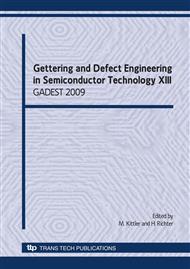[1]
R. Falster, V. V. Voronkov, and F. Quast, phys. stat. sol. (b), 222 (2000), p.219.
Google Scholar
[2]
G. Kissinger, J. Dabrowski, A. Sattler, C. Seuring, T. Müller, H. Richter, and W. von Ammon, J. Electrochem. Soc., 154 (2007), p. H454.
DOI: 10.1149/1.2717492
Google Scholar
[3]
G. Kissinger, D. Kot, J. Dabrowski, V. Akhmetov, A. Sattler, and W. von Ammon, in High Purity Silicon X, C. Claeys, R. Falster, M. Watanabe, and P. Stallhofer, Editors, in: ECS Transactions Vol. 16 No. 8 (2008), p.97.
DOI: 10.1149/1.2980296
Google Scholar
[4]
J. C. Mikkelsen Jr., Mater. Res. Soc. Symp. Proc. 59 (1986), p.19.
Google Scholar
[5]
D. Aberg, B. G. Svensson, T. Hallberg, J. L. Lindström, Phys. Rev. B 58 (1998)-I, p.12944.
Google Scholar
[6]
T. A. Frewen, S. S. Kapur, W. Häckl, W. Von Ammon, T. Sinno, J. Cryst. Growth 279 (2005), p.258.
Google Scholar
[7]
V. V. Voronkov and R. Falster, Mat. Sci. in Semicond. Processing 5 (2003), p.387.
Google Scholar
[8]
D. Kot, T. Mchedlidze, G. Kissinger, and W. Von Ammon, to be published.
Google Scholar
[9]
V. Akhmetov, G. Kissinger, and W. Von Ammon, Appl. Phys. Lett. 94 (2009), p.092105.
Google Scholar
[10]
L.I. Murin, J. L. Lindström, B. G. Svensson, V.P. Markevich, A.R. Peaker, C. A. Londos, Proceedings GADEST'05, Giens, September 25-30, ed. by B. Pichaud, A. Claverie, D. Alquier, H. Richter, M. Kittler, in:, Solid State Phenomena, Vols. 108-109 (2005).
DOI: 10.4028/www.scientific.net/ssp.108-109.267
Google Scholar
[11]
L. I. Murin, V. P. Markevich, M. Suezawa, J. L. Lindström, M. Kleverman and T. Hallberg, Physica B: Condensed Matter, Vols. 302-303 (2001), p.180.
DOI: 10.1016/s0921-4526(01)00425-2
Google Scholar
[12]
L.I. Murin, V.P. Markevich, in: R. Jones (Ed. ), Early Stages of Oxygen Precipitation in Silicon, High Technology, Vol. 17, NATO ASI Series, 3, Kluwer, Dordrecht, 1996, pp.329-336.
Google Scholar
[13]
J. W. Corbett, G. D. Watkins, and R. S. McDonald, Phys. Rev. 135 (1964), p. A1381.
Google Scholar
[14]
H. J. Stein, in: H. J. von Bardeleben (Ed. ), Defects in Semiconductors 14, Materials Science Forum, Vol. 10-12 (1986), pp.935-940.
Google Scholar
[15]
C. A. Londos and L. G. Fytros, J. Appl. Phys., 89 (2) (2001), pp.928-932.
Google Scholar
[16]
R. S. Leigh and B. Szigeti, Phys. Rev. Lett. 19 (1967), p.56.
Google Scholar


